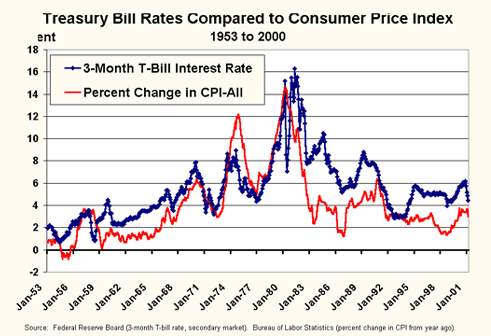Treasury bills
Investors consider U.S. Treasury bills (T-bills) to be the safest short-term financial instrument because these debt obligations are perceived to have no default risk. Moreover, because T-bills mature in less than one year–most mature in several months–they do not have a large interest rate risk component, either.
The large and liquid Treasury bill market plays an important role in the financial system. The December 2000 Federal Reserve Bulletin reported $616.2 billion in Treasury bills were outstanding at the end of the third quarter of 2000.1 T-bills are liquid; there is an active secondary market where they may be traded. They are important financial instruments to individuals, financial institutions, corporations, governments and the Federal Reserve System, all of which hold sizeable amounts of U.S. Treasury debt, including T-bills, in their portfolios.2
T-bill Auctions
The U.S. Treasury sells 3-month and 6-month Treasury bills at weekly competitive auctions.3 4 The auctions (see http://www.publicdebt.treas.gov/sec/sec.htm) take place as part of the Treasury’s effort to manage the federal debt. The prices for new T-bills (and yields—see Appendix) are determined by supply and demand conditions at each auction. The prices and yields for existing T-bills are determined in the secondary market.
What Moves Treasury Bill Interest Rates Up and Down?
Many factors may affect Treasury bill interest rates in general, as well as rates for specific issues of Treasury securities, in particular. Here are several factors you might want to consider:5
- Demand for risk-free fixed-income securities in general—For example, a “flight to safety” caused by concerns about default or liquidity risk in other financial markets may cause investors to shift to T-bills to avoid risk.
- Supply of T-bills by the U.S. government–for example, federal budget surpluses in 1998-2000 have reduced the supply of some Treasury securities issues.6
- Economic conditions may influence rates–for example, Rose (1994) notes that T-bill rates typically rise during periods of business expansion and fall during recessions.7
- Monetary policy actions by the Federal Reserve–Fed actions that affect the Federal funds rate likely will influence interest rates for other close substitutes, including short-term T-bills.
- Inflation and inflation expectations also are factors in determining interest rates–for example, periods of relatively high (low) rates of inflation usually are associated with relatively high (low) interest rates on T-bills (see chart, below).

APPENDIX: Calculating Yields on Treasury Bills for Comparison Purposes
Treasury bills are sold at a discount. The difference between the auction sales price and the value of the T-bill at maturity represents the income from the T-bill. Yields on T-bills are calculated using the bank discount method, as shown below:
|
Discount Rate =
|
Par Value – Purchase Price
|
x
|
_______360 days______
|
|
Par Value
|
Number of days to maturity
|
Because the bank discount method does not account for compounding of interest or the actual number of days in a year (365 or 366), the calculated T-bill discount rate always is lower than the investment yield on a T-bill. You may account for this understatement of the return by converting the discount rate to an investment yield (or coupon-equivalent yield). After making that conversion you may make comparisons with yields on other types of instruments. The following formula converts a discount rate to an investment yield:
|
Investment Yield =
|
_________365 x Discount Rate______
|
|
360 – (Discount Rate x Days to maturity)
|
Endnotes
1. Federal Reserve Bulletin, December 2000, Board of Governors of the Federal Reserve System, Statistical Table 1.41, page A27, Gross Public Debt of U.S. Treasury.
2. Rose, Peter S. 1994. Money and Capital Markets, Irwin, Boston. See Chapter 14, page 369.
3. Federal Reserve Banks no longer sell Treasury debt directly to the public. The public may purchase securities online through TreasuryDirect or directly from commercial banks. The Federal Reserve System continues to participate in processing the auctions.
4. The 52-week T-bill will be discontinued as of February 2001.
5. Dupont, Dominique, and Brian Sack. 1999. “The Treasury Securities Market: Overview and Recent Developments.” Federal Reserve Bulletin, Board of Governors of the Federal Reserve System, December, pages 785-806.
6. The long-term end of the Treasury bond market has been affected by the reduced supply of new debt, which also has affected the shape and slope of the Treasury security yield curve.
References
Dupont, Dominique, and Brian Sack. 1999. “The Treasury Securities Market: Overview and Recent Developments.” Federal Reserve Bulletin, Board of Governors of the Federal Reserve System, December, pages 785-806.
http://www.federalreserve.gov/pubs/bulletin/1999/99index.htm
Federal Reserve Bulletin, 2000. Board of Governors of the Federal Reserve System, December, Statistical Table 1.41, page A27, Gross Public Debt of U.S. Treasury.
Federal Reserve Statistical Release, H.4.1. “Factors Affecting Reserve Balances.” Board of Governors of the Federal Reserve System, December 28, 2000.
http://www.federalreserve.gov/releases/H41/
Meulendyke, Ann-Marie. 1998. U.S. Monetary Policy and Financial Markets. Federal Reserve Bank of New York, New York. See Chapter 4, Financial Markets, especially pages 93-101.
Rose, Peter S. 1994. Money and Capital Markets, Irwin, Boston.
TreasuryDirect website for purchasing U.S. Treasury securities online:
http://www.publicdebt.treas.gov/sec/sec.htm